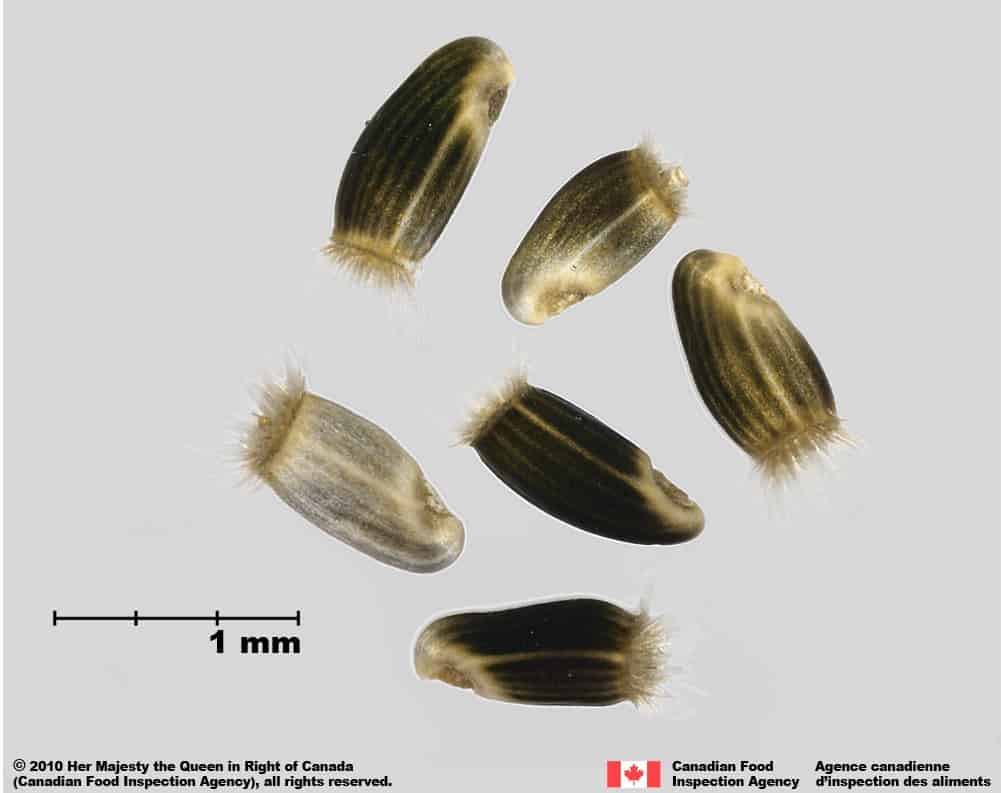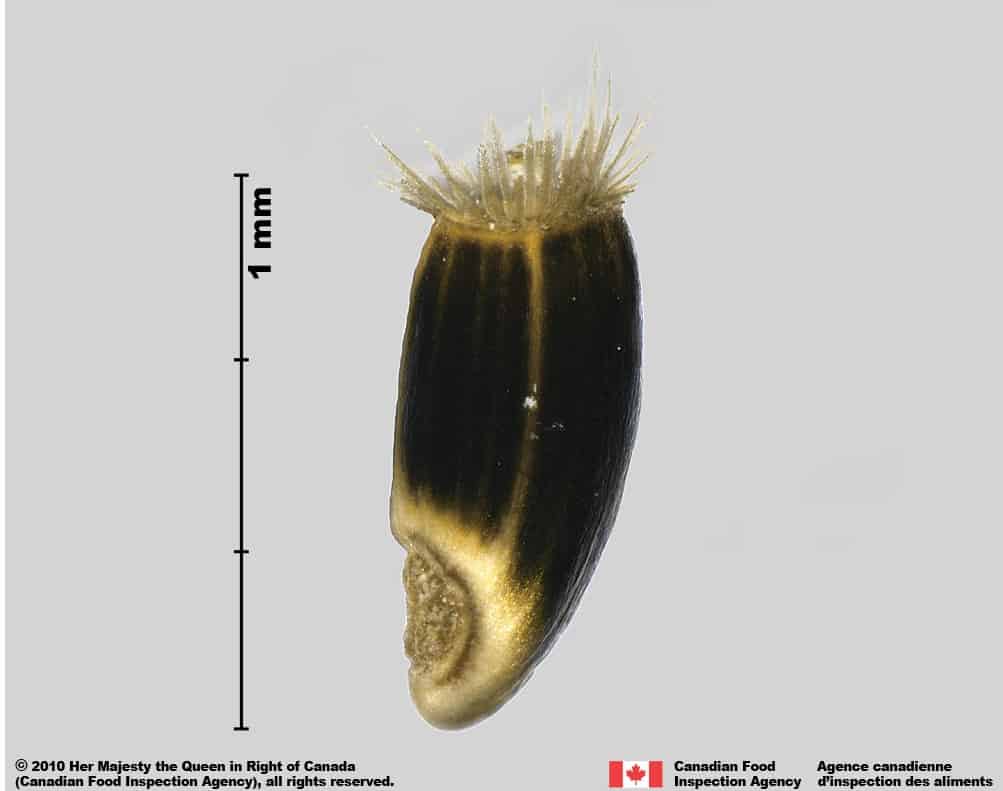Centaurea diffusa
Overview
Aperçu
Regulation :
Remarques Réglementation:
- CFIA Weed Seeds Order - Class 1: Prohibited Noxious Weed Seeds
- Quarantine lists of countries e.g. India *may be updated without notice
Regulation Notes:
Prohibited Noxious, Class 1 in the Canadian Weed Seeds Order (2016) under the Seeds Act. All imported and domestic seed must be free of Prohibited Noxious weed seeds.
Distribution :
Répartition :
This species is native to southeastern Europe and western Asia and has expanded beyond its native range into central and western Europe. It has also been introduced into North America and Argentina (Watson and Renney 1974; CABI 2020). Occurs in Canadian provinces of Alberta, British Columbia, Ontario, Quebec, Saskatchewan (Brouillet et al. 2010+; CABI 2020).
Habitat and Crop Association :
Habitat et Cultures Associées :
Fields, rangelands, grasslands, dunes, open forests, roadsides, railway lines, gravel pits, industrial sites and other disturbed areas (Watson and Renney 1974; CABI 2020). A serious weed of Medicago sativa (alfalfa) in its native range but mainly a weed of rangelands, preferring arid or semi-arid conditions (CABI 2020).
Economic Use, cultivation area, and Weed Association :
Utilisation économique, zone de culture et association de mauvaises herbes :
Duration of Life Cycle :
Durée du cycle vital:
Biennial or perennial
Dispersal Unit Type :
Type d’unité de dispersion :
Achene
General Information
RENSEIGNEMENTS GÉNÉRAUX
Centaurea diffusa was introduced in the Pacific Northwest of the United States through contaminated Medicago sativa (alfalfa) seed and hay, and has since spread through western regions of Canada and the United States (Watson and Renney 1974).
C. diffusa grows in a wide range of soil and environmental conditions but cannot tolerate cultivation or irrigation (Watson and Renney 1974). C. diffusa produces large numbers of achenes that are dispersed by wind, water, and animals (Sheley et al. 1998). Plant stems may break off to become tumbleweeds, dispersing achenes over large distances by wind or vehicle activity (Sheley et al. 1998).
.
Centaurea diffusa infestation (Jennifer Andreas, Washington State University, Bugwood.org)
Identification
Identification
-
Achene
Size
- Achene length*: 1.4 – 2.6 mm; width: 0.7 – 1.1 mm
*Note: minimum and maximum of 20 achenes in a normal range of this species using image measurement (ISMA 2020)
Shape
- Achene is oblong with a narrow, notched end and a wider truncate end, laterally compressed
Surface Texture
- Achene has smooth surface
- Achenes can have scattered surface hairs that are generally removed during processing
Colour
- Achenes are dull or shining light yellow, light grey, reddish-brown or dark greenish-brown, with a wide light yellow central stripe and thin stripes to either side
Other Features
Pappus
- Pappus length: less than 1.0 mm when present (Watson and Renney 1974)
- Pappus may be absent, but when present is comprised of small uneven bristles or scales (White 2008)
Achene end with pappus
- A small style remnant is present in the center of the truncate end
- The rim around truncate end with style remnant is generally glossy light yellow
Achene end without pappus
- Tissue (elaiosome) is generally present in notch but may be removed during processing
- The area around the side notch is generally glossy light yellow

Diffuse knapweed (Centaurea diffusa) achenes






-
Seed
Size
- Seed size is similar to achene size
Shape
- Seed is oblong shaped
Surface Texture
- Seed surface is smooth
Colour
- Seed is yellow or orange coloured
Other Features
- Seed coat thin, dark brown, adhering to the fruit wall
-
Embryo
Size
- The embryo fills the seed
Shape
- Embryo is spatulate, axial position
Endosperm
- Endosperm absent, nutritive tissue stored in the cotyledons
Other Features
- Cotyledons are fleshy and soft-textured
Identification Tips
CONSEILS POUR L’IDENTIFICATION
The achenes of this species are generally distinguished from similar species by their small size, a short, sparse pappus (when present), and shallow side notch.
Additional Botany Information
AUTRES RENSEIGNEMENTS BOTANIQUES
Flowers/Inflorescence
- Flower heads narrow oval or cylindrical shaped, flowers are white, rarely pink or purple (FNA 1993+)
Vegetative Features
- The involucral bracts are egg- or teardrop-shaped with prominent nerves, the edges near the top have small spines
- The bracts protect the seeds as they develop, and disperse them through a hole at the end of the involucre (Watson and Renney 1974)

Centaurea diffusa flowers (K. George Beck and James Sebastian, Colorado State University, Bugwood.org)




Similar Species
ESPÈCES SEMBLABLES
Similar species are based on a study of seed morphology of various species, and those with similar dispersal units are identified. The study is limited by physical specimen and literature availability at the time of examination, and possibly impacted by the subjectivity of the authors based on their knowledge and experience. Providing similar species information for seed identification is to make users aware of similarities that could possibly result in misidentification.
Centaurea stoebe L. (spotted knapweed)
C. stoebe achenes are generally larger (length*: 1.8 – 3.1 mm; width 0.8 – 1.3 mm) with a thicker central stripe, a deeper side notch at the end attached to the flower head, and a longer pappus (length: 1.0 -2.0 mm, Watson and Renney 1974) compared to C. diffusa.
*Note: minimum and maximum of 20 achenes in a normal range of this species using image measurement (ISMA 2020)
Click to select species
Cliquez pour sélectionner les espèces

Centaurea stoebe
Comparison Window
Fenêtre de comparaison
MAIN SPECIES
ESPÈCES PRINCIPALES
Centaurea diffusa

Centaurea diffusa
Asteraceae
Diffuse knapweed (Centaurea diffusa) achenes
MAIN SPECIES
ESPÈCES PRINCIPALES
Centaurea diffusa

Centaurea diffusa
Asteraceae
Diffuse knapweed (Centaurea diffusa) achenes
MAIN SPECIES
ESPÈCES PRINCIPALES
Centaurea diffusa

Centaurea diffusa
Asteraceae
Diffuse knapweed (Centaurea diffusa) achene
MAIN SPECIES
ESPÈCES PRINCIPALES
Centaurea diffusa

Centaurea diffusa
Asteraceae
Diffuse knapweed (Centaurea diffusa) achene
MAIN SPECIES
ESPÈCES PRINCIPALES
Centaurea diffusa

Centaurea diffusa
Asteraceae
Diffuse knapweed (Centaurea diffusa) achene, basal notch
MAIN SPECIES
ESPÈCES PRINCIPALES
Centaurea diffusa

Centaurea diffusa
Asteraceae
Diffuse knapweed (Centaurea diffusa) flower head
SIMILAR SPECIES
ESPÈCES SEMBLABLES
Centaurea stoebe

Centaurea stoebe
Asteraceae
Spotted knapweed (Centaurea stoebe) achenes
SIMILAR SPECIES
ESPÈCES SEMBLABLES
Centaurea stoebe

Centaurea stoebe
Asteraceae
Spotted knapweed (Centaurea stoebe) achenes
SIMILAR SPECIES
ESPÈCES SEMBLABLES
Centaurea stoebe

Centaurea stoebe
Asteraceae
Spotted knapweed (Centaurea stoebe) achene
SIMILAR SPECIES
ESPÈCES SEMBLABLES
Centaurea stoebe

Centaurea stoebe
Asteraceae
Spotted knapweed (Centaurea stoebe) achene; basal notch
SIMILAR SPECIES
ESPÈCES SEMBLABLES
Centaurea stoebe

Centaurea stoebe
Asteraceae
Spotted knapweed (Centaurea stoebe) achene, close-up
SIMILAR SPECIES
ESPÈCES SEMBLABLES
Centaurea stoebe

Centaurea stoebe
Asteraceae
Spotted knapweed (Centaurea stoebe) achene, top-down view
Need ID Help?
Besoin d’aide pour l’identification?
Reference(s)
Référence(s)
Brouillet, L., Coursol, F., Meades, S. J., Favreau, M., Anions, M., Bélisle, P. and Desmet, P. 2010+. VASCAN, the database of vascular plants of Canada. http://data.canadensys.net/vascan/ Accessed October 15, 2020.
Centre for Agriculture and Bioscience International (CABI). 2020. Invasive Species Compendium, CAB International, Wallingford, UK. https://www.cabidigitallibrary.org/journal/cabicompendium Accessed October 8, 2020.
Flora of North America (FNA) Editorial Committee, eds. 1993+. Flora of North America North of Mexico [Online]. 22+ vols. New York and Oxford. http://beta.floranorthamerica.org. Accessed December 29, 2022.
Global Biodiversity Information Facility (GBIF) Secretariat. 2022. https://doi.org/10.15468/39omei Accessed via https://www.gbif.org/species/3128962 Accessed December 29, 2022.
Government of Canada (GC). 2016. Canadian Weed Seeds Order. https://laws-lois.justice.gc.ca/eng/regulations/SOR-2016-93/page-2.html (English) https://laws-lois.justice.gc.ca/fra/reglements/DORS-2016-93/page-2.html (French)
International Seed Morphology Association (ISMA). 2020. Method for Seed Size Measurement. Version 1.0. ISMA Publication Guide. https://www.idseed.org/authors/details/method_for_seed_size_measurement.html
Sheley, R. L., Jacobs, J. S., and Carpinelli, M. F. 1998. Distribution, Biology, and Management of Diffuse Knapweed (Centaurea diffusa) and Spotted Knapweed (Centaurea maculosa) Weed Technology. 12: 353-362.
White, M.R. 2008. Field Guide to Noxious and Invasive Weeds Known to Occur or are Occurring on the Apache-Sitgreaves National Forests. USDA Forest Service, Southwestern Region, MR-R3-01-2. Albuquerque, NM. 233 pp.
Watson, A. K., and Renney, A. J. 1974. The biology of Canadian weeds 6. Centaurea diffusa and C. maculosa. Canadian Journal of Plant Science 54: 687-701.




